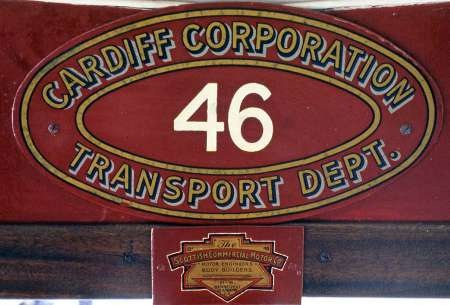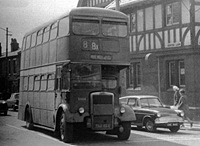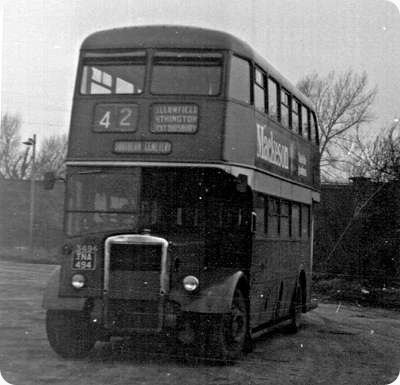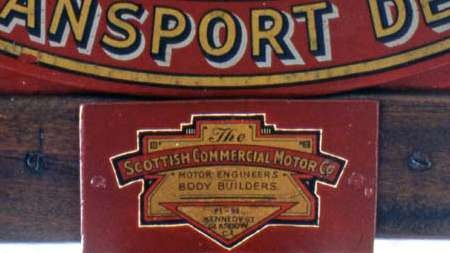Manchester Corporation – Leyland Titan – TNA 494 – 3494
Manchester Corporation
1958
Leyland Titan PD2/40
Burlingham H37/28R – Leyland H32/28R
Mention has been made elsewhere on this site of Manchester 3494 getting beheaded at the Bridgewater Canal and gaining the body from 3363, the chassis of which had been damaged in an accident.
The above photo is a photo of 3494 with its original Burlingham body shown at the top of Kenyon Lane, Moston at the Ben Brierley in 1966.
This next photo was taken when Keith Walker, Peter Thompson and I were visiting Parrs Wood depot in March 1969 and shows 3494 with its Leyland Farringdon body from 3363.
It was good to see the name of Malcolm Crowe on the Old Bus Photos site. Malcolm was one of the people who introduced me to buses outside Britain and although his photos of Portugal were a revelation, I have unfortunately never been able to get there. I’ve been to a lot of other places but still want to get to Portugal.
Peter Dorricott mentioned that when he was driving at Birchfields Rd depot he was told that bus restoration took place in one of the disused entrances. My former English Teacher at Plant Hill Comprehensive, Miss Bates had a boyfriend who was involved in the restoration of Manchester tram 765 and through her, Geoff Guinn and I were invited to Birchfields Rd one evening to see work on 765. It was a fantastic piece of restoration work. Later of course 765 ran at Heaton Park and Crich.
Mention of old coach operators and going on tours from newsagents brought to mind some of the usual operators used to get from New Moston to Scarborough, Blackpool, Morecambe and Southport. Wilsons Coaches of Failsworth had a Maudslay half-cab which I remember well but of course by the time I was old enough to understand how rare and beautiful it was, it had gone, although I was later told it was lying in a corner of the their garage. The other local operator was Threlfall’s, evidently related to the beer concern.
Photograph and Copy contributed by Ian Lynas
15/03/13 – 08:40
Ian, I presume you are in possession of a higher-resolution photo of the bus passing the Ben Brierley and therefore in a position to state with confidence that it is actually 3494 which is depicted. Looking at the above pic I would have guessed at other than 3494, but one of my ‘alternatives’ wouldn’t have been a TNA so that would obviously be out.
‘Farringdon’ should of course be ‘Farington’ – and yes, I am not going to let myself be roped in to the perennial debate regarding which Leyland bodies were genuine ‘Faringtons’!
Talking of Leyland bodies, does anyone know (I suspect that I should really know the answer to this one myself) if a Leyland body was ever fitted to other than a Leyland chassis? I’m pretty sure that Leyland never put one of their bodies on anyone else’s chassis, but did any operators do any transferring?
David Call
15/03/13 – 08:41
The photograph of 3494 was taken on the occasion of a visit to Parr’s Wood garage on 15th March 1969 by a PSV Circle tour to commemorate the last Manchester PD1/3s. There were plenty of people travelling as there were two PD1/3s and also Daimler CVG6 4127 (now preserved)! I have a similar photograph, but not very good as it was taken with an Instamatic camera.
After the closure of Parr’s Wood garage 3494 moved to Hyde Road and I find I noted it working on the express services to Saddleworth on occasions. I wish I’d made the effort to photograph it!
To the right of the bus is the former Midland Railway route to London from Manchester which closed about that time. It has since been converted to a Metrolink route, but has not yet opened (that’s a few months away). Parr’s Wood garage itself closed in 1970 and is now a Tesco supermarket – all that’s left of the original is the clock tower.
David Beilby
15/03/13 – 11:13
Ian, thanks for posting those shots. Have you a date, at least to the month, of the shot of the Burlingham body? The reason I ask is that 3494 was, as far as I remember, a Parrs Wood vehicle for a good deal of its life in both guises.
The accident took place in October 1966 on route 22, a Parrs Wood route, so what is 3494 doing very much in Rochdale Rd depot territory, sans offside nut guard ring anathema at Parrs Wood at the time)?
Another point of interest is the position of the registration plate. As far back as March 1958 MCTD wrote to Burlingham pointing out that, as radiator shells were sometimes exchanged, plates should be placed on the body and this was done from the July 1958 onwards deliveries (3495 – delayed from February – and 3503 onwards). There’s a picture in The Manchester Bus of Orion bodied PD2 3611 carrying its correct plate UNB 611) on the front cab panel at the same time as it has TNA 480 on a plate on an obviously swapped radiator shell from Burlingham bodied PD2 3480. Given all of that it’s odd that 3494 still has its plate on the radiator after eight years and a visit for major overhaul and total respray. Indeed preserved 3496 which is preserved as it was after respray into the all red scheme still has its plate on the radiator as it was after withdrawal.
In the light of David Call’s comment and my suspicions, I’ve played around with the photo and used a magnifying glass and the shot with the Burlingham body looks like 3484, which would make sense as it was allocated to either Rochdale Rd or Queens Rd – I think it was the former.
Phil Blinkhorn
15/03/13 – 12:15
I’ve long had the idea – without any substantiation – that the Burlingham bodies supplied to Manchester were rather more upright (Orion fashion) than those they supplied to Ribble. How far adrift from reality am I this time
Pete Davies
15/03/13 – 14:50
Interesting question from David Call. I wonder what the response from Leyland would have been if someone had asked them to body a chassis other than one of their own!
But yes, the wonderful Green Bus Company of Rugeley, Staffs created one when they rebodied a Foden which had been a coach with a Leyland d/d body, both of which were pre-war. So there you are, a Leyland bodied Foden, if only a picture existed!
Chris Barker
15/03/13 – 14:51
Pete, you are absolutely correct. The front profile was to Manchester’s own upright design, the window radii were slightly reduced and the rear profile was also more upright.
Phil Blinkhorn
15/03/13 – 16:35
Referring to David Call’s question about non-Leyland chassis carrying Leyland bodies, Bamber Bridge Motor Service created such a vehicle. In 1950, they acquired BRD 755, a 1943 Guy Arab I 5LW/Strachans L27/28R ex Reading Corporation. In 1953, they rebodied it with the Leyland L27/26R body from Leyland TD4 ATD 596, which they had bought new in 1935. That Leyland chassis and the discarded Strachans body were scrapped. The Guy gave a couple of years more service to BBMS before passing to Leak, Preston in 1955, and going for scrap in 1956.
David Williamson
15/03/13 – 17:55
To the best of my knowledge no new Leyland body went on other makes of chassis. CIE built their own version of the standard Leyland body with three screens upstairs at the front – including on PD3s. I seem to remember reading somewhere that there were also examples of this body built new on to AEC and Daimler chassis.
David Oldfield
16/03/13 – 07:31
CIE had a great mixture of their own versions of Leyland’s Colin Bailey designed body, all most all of which retained the original 1930s single pane upper deck rear emergency exit window see: www.busesinireland.com/1 and www.busesinireland.com/2
There were a number of two and three pane front upper deck window variants as well as five, six and SEVEN bay body construction. Some were totally anachronistic such as the SEVEN bay, three pane OPD3s see: www.busesinireland.com/3
Some AR class Regents did not have Leyland style bodies see: www.busesinireland.com/4 These were delivered ckd for GNR(I) but I can’t definitively confirm the bodybuilder though I suspect Park Royal. Half of these were subsumed into the CIE fleet when GNR(I) was split between CIE and Ulsterbus.
Those imported in 1946/7 for CIE did have a Leyland style body see: www.nationaltransportmuseum.org
I haven’t found a picture of any of the six DR class Daimler CWD6s but as the chassis and bodies were supposedly delivered ckd from the UK I very much doubt they would have had anything resembling a Leyland body though I’d love to see a photo if they did!.
Phil Blinkhorn
16/03/13 – 08:49
CIE’s three AA-class Regent Vs had Leyland-style bodies, and they were seven-bay (like the RA-class PD3s). Here’s a pic www.busweb.co.uk/
David Call
16/03/13 – 14:50
Nice find David. I assume the lack of lower deck windows towards the rear was because the space on the lower deck offside was used for luggage – not to mention the assorted livestock and parcel deliveries CIE used to handle, even in the cities.
Phil Blinkhorn
16/03/13 – 18:47
In the early postwar period, Alexander built some bodies of Leyland design under licence and Cardiff had a batch of Crossley DD42’s delivered new with this style of bodywork. Although not strictly Leyland bodies they were Leyland in appearance and gave a good impression of what a Leyland body looks like on a non-Leyland chassis.
Philip Halstead
17/03/13 – 05:54
One thing I didn’t think to mention about the CIE AAs was that their initial use was to replace passenger trains between Waterford and Tramore, and they were known to have increased luggage capacity. The extra panelling is unusual, though.
The Cardiff Crossleys are more often than not quoted as having Scottish Commercial, rather than Alexander bodies, although several versions of the story seem to exist, e.g. the bodywork was subcontracted from Alexander, or that Scottish Commercial panelled the Alexander frames. One of the batch, 46 (EBO 900), was preserved and is apparently still in storage, but hasn’t been used for many years. There are several photos of it on the net (both before and during preservation), and this is about the best www.flickr.com/
David Call
17/03/13 – 05:56
Interesting Philip since Alexander made such bodies on Titans for Leyland – under licence and with official sanction.
David Oldfield
17/03/13 – 09:54
A better photo from the point of view of seeing just how Leyland the body is can be found on here: www.mikestreet.webplus.net/ The side view is totally Leyland, as is the rear upper deck emergency exit but the driver’s dash panel, the Crossley headlamps and mudguards change the look of the vehicle even more than the Crossley radiator.
Phil Blinkhorn
17/03/13 – 11:38
The attached photograph should materially assist the confusion regarding the bodywork on Cardiff 46! 
In fact I believe it is the cause the confusion, as the Scottish Commercial plate is of them acting in the capacity of dealers rather than coachbuilders. They were Crossley agents and had apparently sub-contracted the coachwork to Alexander.
The confusion is probably also helped by the fact Cardiff already had some Crossleys with Scottish Commercial bodies. These, like the lowbridge examples were bought through Almondsbury Engineering and two even had Gloucestershire registrations. They had the more traditional Scottish Commercial appearance, which was a squared-off Manchester style.
Western SMT created an unusual hybrid when they rebodied wartime Guy Y191 (ASD 253) with the Leyland body off TD5 D138 (CS 7037). There is a picture of it in Buses Annual 1970, but the effect was lost as the front was flattened and looked more like a rebuilt utility body. You had to look further back to see the Leyland lineage.
David Beilby
17/03/13 – 15:39
Neither Leyland nor Alexander had 4-bay bodies during this period. (re Cardiff buses) I seem to remember seeing some exposed radiator Regents with Park Royal built Leyland lookalike bodies, but I can`t remember where.
Jim Hepburn
17/03/13 – 15:40
I’m sure I picked it up on the net once that Almondsbury Engineering were a company which ordered the three highbridge Crossleys for their own staff transport, but very quickly decided they weren’t required, or perhaps Almondsbury went out of business, I’m not certain now. This does seem basically consistent with the wording on the Mike Street site, linked to above. I haven’t previously encountered the notion that Almondsbury were agents for the manufacturer(s). My apologies, of course, David, if they were.
Perhaps some Cardiff-area contributors could settle this one?
David Call
17/03/13 – 15:41
In 1936 and 37 East Midland received 16 Leyland TS7’s with Leyland B35R bodies. These were re-bodied in 1939 with new ECW DP35R bodies. The Leyland bodies were then fitted to some 1930-1 AEC Regals whose bodies were scrapped.
Then in 1947-8 a batch of new AEC Regal I’s were delivered for which bodies were not immediately available, so 14 of the Leyland bodies were transferred from the pre-war Regals onto these new chassis, the remaining 2 being sold on.
The new Regals were then re-bodied by Willowbrook (B35R) in 1951.
John Bunting
17/03/13 – 17:18
David, my reference to Almondbury’s involvement in the lowbridge Crossleys came from the Crossley book and was something I was unfamiliar with until I looked it up for my reply. Your interpretation of the history of the three highbridge examples is pretty much the story as I understand it as well.
David Beilby
18/03/13 – 12:20
Alexander bodied some AEC Regents for Scottish Omnibuses after the war which were based on the pre-war Leyland design There is a shot of one on www.sct61.org.uk
Chris Hough
18/03/13 – 15:42
I remember these buses Chris. They were Regent 3s with preselect gears. They came into service in 1948. They looked very much like a Leyland at the front but had more of a utility look at the rear. Alexanders later refined this body to look more like a Leyland lowbridge body and used it for their own PD1s.
Jim Hepburn
06/09/13 – 16:30
Coras Iompair Eireann (CIE) owned 150 Leyland bodied buses delivered to them in the years 1948/9. One hundred complete Leyland double deckers of the standard Titan chassis and body design then in production for British operators Numbered, R291-390 were delivered between 1948 and 1949. These buses soon became known a ‘Boltons’ due to there similarity to those buses also being operated by Bolton Corporation. A further 50 complete Leyland buses, R391-440 were bought to complete the tram conversion programme in 1949. This batch were known as the ‘Capetown’ class. They differed from the earlier ‘Bolton’ type in having a number of CIE design features and so resembled pre-war Leyland bodies. Twenty nine of this class, R411-440 were PD2/1 chassis of 7ft6in width.
David J. White
 Vehicle reminder shot for this posting
Vehicle reminder shot for this posting
18/02/14 – 11:38
Sorry to be away from the site for so long, but the intervening period since 15th March 2013 has been taken up with visiting Japan, organising and getting married, visiting the U.S.A., a myriad of jobs at a new house and further work on Australian buses histories.
So my apologies to David Call, Phil Blinkhorn and David Beilby. To David Call, unfortunately I don’t have the negative of 3484 (that I thought was 3494 – although I must admit to not remembering that 3494 was a Southern bus, not a Rochdale Rd bus). Before leaving U.K. I "gave" away a lot of negatives, not understanding the value of them.
In Australia I have sorted all my prints and finally sorted which ones still had negatives and which didn’t. I’ve then scanned those prints without negs (of which 3484 was one because I gave most of my Manchester negs away – bright boy – not). The negs from my Bencini camera are actually reasonably good and its surprising how many rolls sent to a company in Brighton for printing all those years ago, which came back "unable to be printed – too dark" now print up beautifully and I include in those a "Metalcraft" bodied Foden taken on a PSV Circle Tour and a rare Daimler with one of the Doncaster operators on another PSV Circle Tour (sorry I cant be any more precise because I’m at work and don’t have access to my photo folders).
Just looking at a photo of Ashton 67 and Oldham 408 in Wallshaw St – I was on that tour also and have a similar photo to the one posted. I don’t have a neg of that photo either.
Regards to all the fans in the Manchester area and I’m still working on the history of the Panthers and Panthers Cubs that came to Australia. One or two have survived as motor homes.
Ian Lynas
Quick links to the - Comments Page - Contact Page - Home Page
Please leave a comment
Please Note if you want to send a photograph with your comment please use the Contact Page by clicking here or send as an attachment via email.



